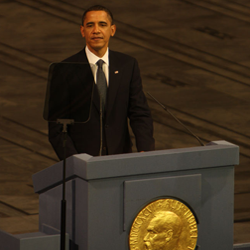
In fact, when he received the Nobel Peace Prize, Mr President Barack H. Obama said: “[…] the world must come together to confront climate change. There is little scientific dispute that if we do nothing, we will face more drought, more famine, more mass displacement –all of which will fuel more conflict for decades.” However, despite President Obama’s words, some dispute exists about the statistical consistency of some results linking climate change and the arousal of conflict.
In general grounds, hundreds and hundreds of studies have analysed the influence of climate change on human behaviour from the point of view of sociology, psychology and physiology. Not to forget, we are animals, and as such it is only natural that we are influenced by our environment and, particularly, by climate. A recent study by the Kiel Institute for the World Economy analysed which are the factors life satisfaction depends on. They analysed the answers to question V22 (“All things considered, how satisfied are you with your life as a whole these days?”) of the World Values Survey and found a significant and consistent relation with income, population and climate. They also found that, for the specified model, life is most satisfactory in mild climates where temperatures do not depart much from 65 ºF (18.3 ºC).
More specific to the subject, two studies with contrasting results have dealt with the effect of climate change on civil wars. The first one, by Marshall B. Burke and others, related the occurrence of civil wars in sub-Saharan Africa with temperatures and predicted an increase in the frequency of armed conflicts by about 50% by 2030. Temperature is of great importance for crop yields because evapotranspiration (and water demand) increase with temperature and crop development accelerates, with a likely decrease in agricultural production. Given the importance of agriculture for the African economy, the authors suggest that crop yield declines can have important economic impacts that can trigger civil conflicts. Moreover, according to the study, adverse climate effects might overcome beneficial economic development effects.
This article was contested by Halvard Buhaug from the Centre for the Study of Civil War, who realized a more detailed analysis of the interrelations between climate and civil war. He tried the consistency of the previous paper results by using different more widely accepted definitions of civil war, considered outbreak and incidence as different processes and took into account other climate and socioeconomic variables. As a result, the link between armed conflict and climate variables was only observed for the original model specification, meaning that previous results might be an artefact due to the specific statistical assumptions used. The main point made by Buhaug is that civil conflicts are more influenced by political conditions than climate. However, Burke’s group points to econometric mistakes in Buhaug’s work and Buhaug himself acknowledges that the resolution of the data used (aggregate country-level statistics) might not be representative of climate and conflict geographic variability, which could mask existing relations.
The latest chapter in this dispute has been written by Solomon M. Hsiang and collaborators with an article published in Nature a few weeks ago. In this case, the emphasis was put on the relation between global climate, represented by ENSO (El Niño/Southern Oscillation) events, and conflict risk at planetary scale. In countries most strongly affected by ENSO variability, conflict risk doubles from 3% to 6% in El Niño (warm sea surface temperatures in the Eastern Pacific) periods. Since ENSO variations may be predicted two years in advance this result can be of great use in preparing for some conflicts and humanitarian crises. Yet, given the complexity of the direct and indirect effects of climate on human affairs, the application of the observed relations to the prediction of climate change effects on global security is not possible until we have a better knowledge of the mechanisms used by climate to influence war likelihood.




